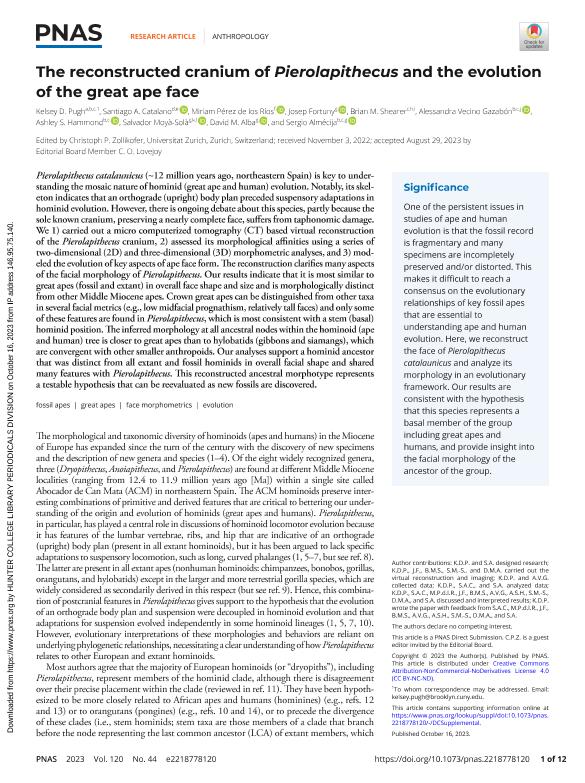Mostrar el registro sencillo del ítem
dc.contributor.author
Pugh, Kelsey D.
dc.contributor.author
Catalano, Santiago Andres

dc.contributor.author
Pérez de los Ríos, Miriam
dc.contributor.author
Fortuny, Josep

dc.contributor.author
Shearer, Brian M.
dc.contributor.author
Vecino Gazabón, Alessandra
dc.contributor.author
Hammond, Ashley S.
dc.contributor.author
Moyà Solà, Salvador
dc.contributor.author
Alba, David M.
dc.contributor.author
Almécija, Sergio
dc.date.available
2023-11-03T18:00:38Z
dc.date.issued
2023-10
dc.identifier.citation
Pugh, Kelsey D.; Catalano, Santiago Andres; Pérez de los Ríos, Miriam; Fortuny, Josep; Shearer, Brian M.; et al.; The reconstructed cranium of Pierolapithecus and the evolution of the great ape face; National Academy of Sciences; Proceedings of the National Academy of Sciences of The United States of America; 120; 44; 10-2023; 1-12
dc.identifier.issn
0027-8424
dc.identifier.uri
http://hdl.handle.net/11336/216998
dc.description.abstract
Pierolapithecus catalaunicus (~12 million years ago, northeastern Spain) is key to understanding the mosaic nature of hominid (great ape and human) evolution. Notably, its skeleton indicates that an orthograde (upright) body plan preceded suspensory adaptations in hominid evolution. However, there is ongoing debate about this species, partly because the sole known cranium, preserving a nearly complete face, suffers from taphonomic damage. We 1) carried out a micro computerized tomography (CT) based virtual reconstruction of the Pierolapithecus cranium, 2) assessed its morphological affinities using a series of two-dimensional (2D) and three-dimensional (3D) morphometric analyses, and 3) modeled the evolution of key aspects of ape face form. The reconstruction clarifies many aspects of the facial morphology of Pierolapithecus. Our results indicate that it is most similar to great apes (fossil and extant) in overall face shape and size and is morphologically distinct from other Middle Miocene apes. Crown great apes can be distinguished from other taxa in several facial metrics (e.g., low midfacial prognathism, relatively tall faces) and only some of these features are found in Pierolapithecus, which is most consistent with a stem (basal) hominid position. The inferred morphology at all ancestral nodes within the hominoid (ape and human) tree is closer to great apes than to hylobatids (gibbons and siamangs), which are convergent with other smaller anthropoids. Our analyses support a hominid ancestor that was distinct from all extant and fossil hominids in overall facial shape and shared many features with Pierolapithecus. This reconstructed ancestral morphotype represents a testable hypothesis that can be reevaluated as new fossils are discovered.
dc.format
application/pdf
dc.language.iso
eng
dc.publisher
National Academy of Sciences

dc.rights
info:eu-repo/semantics/openAccess
dc.rights.uri
https://creativecommons.org/licenses/by-nc-nd/2.5/ar/
dc.subject
PIEROLAPITHECUS
dc.subject
3D MODELS
dc.subject
APE FOSSILS
dc.subject
SKULL
dc.subject.classification
Biología

dc.subject.classification
Ciencias Biológicas

dc.subject.classification
CIENCIAS NATURALES Y EXACTAS

dc.title
The reconstructed cranium of Pierolapithecus and the evolution of the great ape face
dc.type
info:eu-repo/semantics/article
dc.type
info:ar-repo/semantics/artículo
dc.type
info:eu-repo/semantics/publishedVersion
dc.date.updated
2023-11-01T15:29:51Z
dc.journal.volume
120
dc.journal.number
44
dc.journal.pagination
1-12
dc.journal.pais
Estados Unidos

dc.journal.ciudad
Washington D.C
dc.description.fil
Fil: Pugh, Kelsey D.. City University of New York; Estados Unidos
dc.description.fil
Fil: Catalano, Santiago Andres. Consejo Nacional de Investigaciones Científicas y Técnicas. Centro Científico Tecnológico - Tucumán. Unidad Ejecutora Lillo; Argentina. Universidad Nacional de Tucumán. Facultad de Ciencias Naturales e Instituto Miguel Lillo; Argentina
dc.description.fil
Fil: Pérez de los Ríos, Miriam. Universidad Complutense de Madrid. Facultad de Biología; España
dc.description.fil
Fil: Fortuny, Josep. Institut Català de Paleontologia Miquel Crusafont.; España
dc.description.fil
Fil: Shearer, Brian M.. New York Consortium in Evolutionary Primatology; Estados Unidos. New York University Grossman School of Medicine; Estados Unidos
dc.description.fil
Fil: Vecino Gazabón, Alessandra. American Museum of Natural History; Estados Unidos. New York Consortium in Evolutionary Primatology; Estados Unidos
dc.description.fil
Fil: Hammond, Ashley S.. American Museum of Natural History; Estados Unidos. New York Consortium in Evolutionary Primatology; Estados Unidos
dc.description.fil
Fil: Moyà Solà, Salvador. Institut Català de Paleontologia Miquel Crusafont.; España. Institució Catalana de Recerca i Estudis Avancats; España. Universitat Autònoma de Barcelona; España
dc.description.fil
Fil: Alba, David M.. Institut Català de Paleontologia Miquel Crusafont.; España
dc.description.fil
Fil: Almécija, Sergio. American Museum of Natural History; Estados Unidos. New York Consortium in Evolutionary Primatology; Estados Unidos. Institut Català de Paleontologia Miquel Crusafont; España
dc.journal.title
Proceedings of the National Academy of Sciences of The United States of America

dc.relation.alternativeid
info:eu-repo/semantics/altIdentifier/url/https://pnas.org/doi/10.1073/pnas.2218778120
dc.relation.alternativeid
info:eu-repo/semantics/altIdentifier/doi/http://dx.doi.org/10.1073/pnas.2218778120
Archivos asociados
